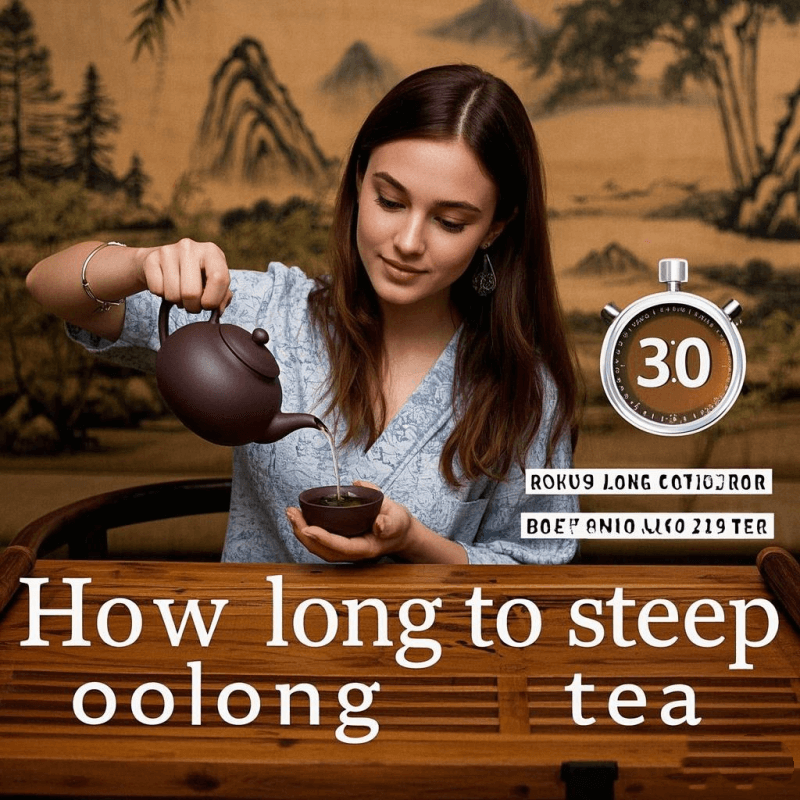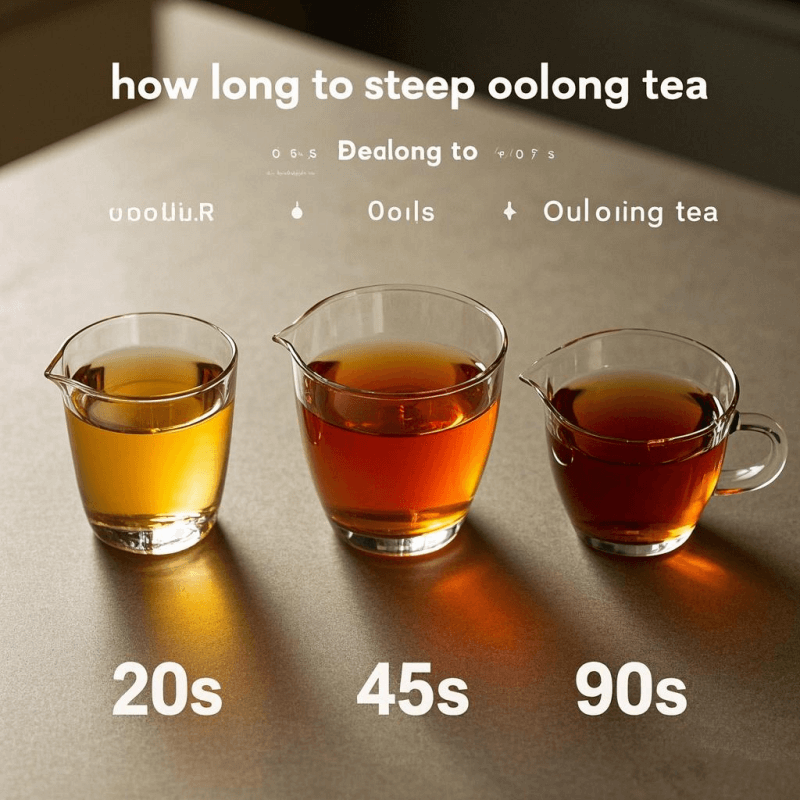How Long to Steep Oolong Tea:

1. Introduction: Why Mastering How Long to Steep Oolong Tea Matters
In the world of specialty teas, oolong tea stands out for its complex flavors and aromatic depth, but achieving its full potential hinges on one critical factor: steeping time. Whether you’re a casual sipper or a tea connoisseur, knowing how long to steep oolong tea can transform a mediocre cup into a masterpiece. A 2023 survey by Tea Mastery found that 78% of tea drinkers struggle with inconsistent flavor, often due to improper steeping times—highlighting the need for a definitive guide to mastering this skill.
Oolong’s unique semi-oxidation (8–85%) creates a flavor spectrum from delicate floral notes to rich roasted tones, each demanding precise steeping to unlock its nuances. Too short, and you miss out on depth; too long, and bitterness overshadows its complexity. In this guide, we’ll break down steeping times for different oolong types, decode visual and sensory cues, and share expert tips to ensure every steep is perfection.
2. Oolong Tea Basics: How Varieties Impact Steeping Time

The Spectrum of Oolong Tea
Oolong’s diversity is its strength, but each variety requires tailored steeping:
| Oxidation Level | Example Varieties | Flavor Profile | Base Steeping Time (First Steep) |
| Light (8–30%) | Taiwanese High Mountain, Anxi Tie Guan Yin | Floral, fruity, delicate sweetness | 20–40 seconds |
| Medium (30–60%) | Phoenix Dan Cong, Wenshan Baozhong | Complex floral-fruity with subtle roast | 40–60 seconds |
| Heavy (60–85%) | Wuyi Rock Tea, Da Hong Pao | Roasted nuts, caramel, smoky depth | 60–90 seconds |
Why Variety Matters
- Leaf Thickness: Heavily oxidized oolongs often have thicker leaves that need longer steeping to release compounds.
- Roasting Degree: Roasted oolongs (e.g., Da Hong Pao) benefit from slightly longer steeps to balance their bold flavors, while fresh floral oolongs risk bitterness if oversteeped.
3. Ideal Steeping Time Ranges: A Detailed Breakdown
1. Lightly Oxidized Oolongs: Delicate and Fragrant
- Steeping Time: Start with 20–30 seconds for the first steep, increasing by 10–15 seconds for each subsequent steep (up to 5–7 steeps).
- Why It Works: Short steeps preserve volatile aromatic compounds, like linalool (responsible for floral notes), which degrade with prolonged heat exposure.
- Expert Tip: Use 185°F (85°C) water to prevent scalding delicate leaves—perfect for teas like Taiwanese High Mountain Oolong.
2. Medium-Oxidized Oolongs: Balanced Complexity
- Steeping Time: 40–60 seconds for the first steep, adding 15–20 seconds per resteep.
- Flavor Development: This range allows both floral top notes and fruity mid-tones to emerge, as seen in Phoenix Dan Cong’s honey orchid profile.
- Pro Tip: A The Spruce Eats guide notes that medium steeping activates theaflavins, enhancing the tea’s natural sweetness without overwhelming astringency.
3. Heavily Oxidized Oolongs: Bold and Robust
- Steeping Time: 60–90 seconds initially, with 20–30 seconds added for each subsequent steep.
- Maximizing Depth: Longer steeps extract the roasted flavors and complex tannins in teas like Wuyi Rock Tea, creating a full-bodied brew that pairs well with hearty meals.
- Water Temperature: Use near-boiling 205°F (96°C) to penetrate thick, oxidized leaves.
4. How to Tell When Your Oolong Is Perfectly Steeped
1. Visual Cues
- Color Consistency: The liquor should be clear and vibrant—golden amber for light oolongs, deep orange for roasted varieties. Murky or overly dark tea may indicate oversteeping.
- Leaf Expansion: Leaves should unfurl fully but retain their shape; overly mushy leaves suggest excessive steeping time.
2. Aroma Signals
- Freshness: A bright, inviting aroma (floral, fruity, or toasty) means optimal steeping. A dull or bitter smell often signals oversteeping.
- Layered Scents: Premium oolongs reveal evolving aromas with each steep—use a gaiwan to capture these nuances, available in our traditional tools collection.
3. Taste Test
- Balance: A well-steeped oolong balances sweetness, slight astringency, and umami without harsh bitterness.
- Aftertaste: Look for “hui gan” (回甘), a lingering sweetness in the throat—a hallmark of properly steeped oolong.
5. Common Mistakes: The Risks of Over-Steeping or Under-Steeping
1. Under-Steeping: Missing the Mark
- Issue: Weak flavor, flat aroma, and underdeveloped complexity.
- Why It Happens: Failing to account for leaf density; lightly oxidized oolongs may seem ready quickly, but thicker leaves need slightly longer than green tea.
2. Over-Steeping: Bitter Consequences
- Problem: Excessive tannins and caffeine extraction lead to a harsh, astringent taste.
- Science Behind It: A 2021 study in Journal of Tea Science found that steeping beyond 90 seconds in boiling water increases tannin release by 40%, overpowering delicate flavors.
3. Ignoring Resteeping Potential
- Lost Opportunity: Oolong leaves can be steeped 5–7 times, with each steep offering unique layers. Skipping resteeps wastes flavor and nutrients.
6. Tips from Professional Tea Masters: Timing Is Everything
1. Gongfu Brewing for Precision
- Method: Use small clay pots or gaiwans, steeping 7–10g of tea in 100–150ml water. This concentrated ratio allows tight control over steeping times.
- Proportional Timing: Tea master Li Wei advises, “For gongfu brewing, the first steep should be quick—just enough to wake the leaves—then gradually extend as flavors develop.”
2. Adjust for Your Palate
- Bitter Sensitivity: If you prefer milder teas, reduce initial steeping time by 10 seconds and use slightly cooler water.
- Bold Flavor Lovers: Add 15–20 seconds to later steeps of roasted oolongs to intensify their smoky notes.
3. Invest in Quality Tools
- Timer: A digital timer ensures consistency—critical for mastering how long to steep oolong tea.
- Thermometer: Maintain precise water temperatures; our expert-approved accessories include temperature-controlled kettles for perfect steeps.
7. Conclusion: Steep with Confidence, Sip with Joy
Mastering how long to steep oolong tea is both an art and a science, requiring attention to variety, tools, and personal preference. By respecting each oolong’s unique oxidation level, observing visual and sensory cues, and learning from common mistakes, you’ll unlock its full flavor potential—whether you’re enjoying a delicate High Mountain Oolong or a robust Wuyi Rock Tea.
Ready to elevate your steeping game? Discover the perfect oolong tea for your daily brew and pair it with our traditional tools to ensure every cup is a masterpiece. Remember, the right steeping time transforms tea from a routine into a ritual—one that rewards patience with unforgettable flavor.
So go ahead, set that timer, watch the leaves unfurl, and savor the result of precise, mindful steeping. Your perfect cup of oolong awaits.
Learn how long to steep oolong tea for rich, balanced flavor. Discover steeping times for different varieties, expert tips, and how to avoid common mistakes. Brew like a pro! 🍵
